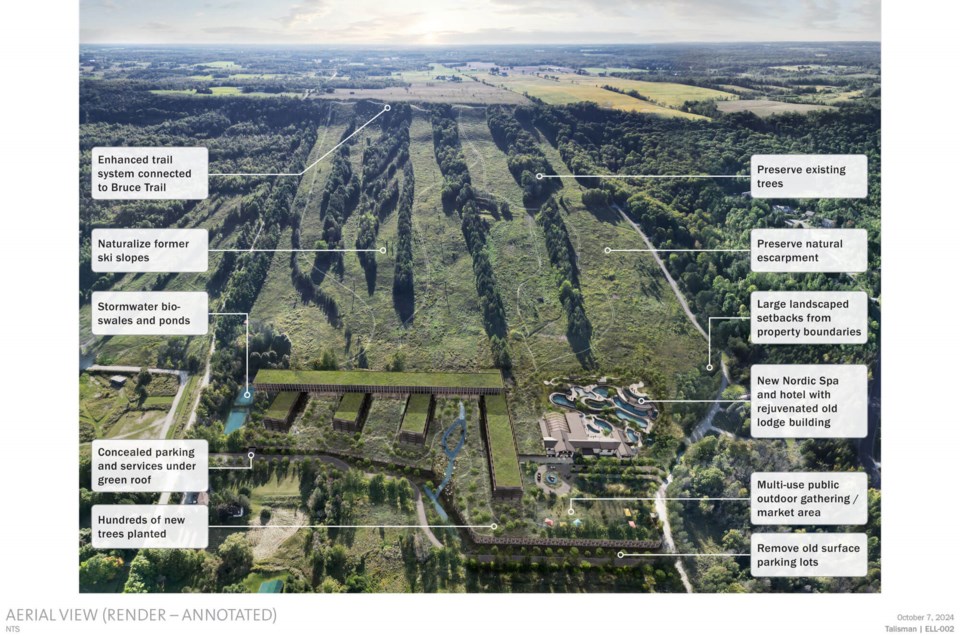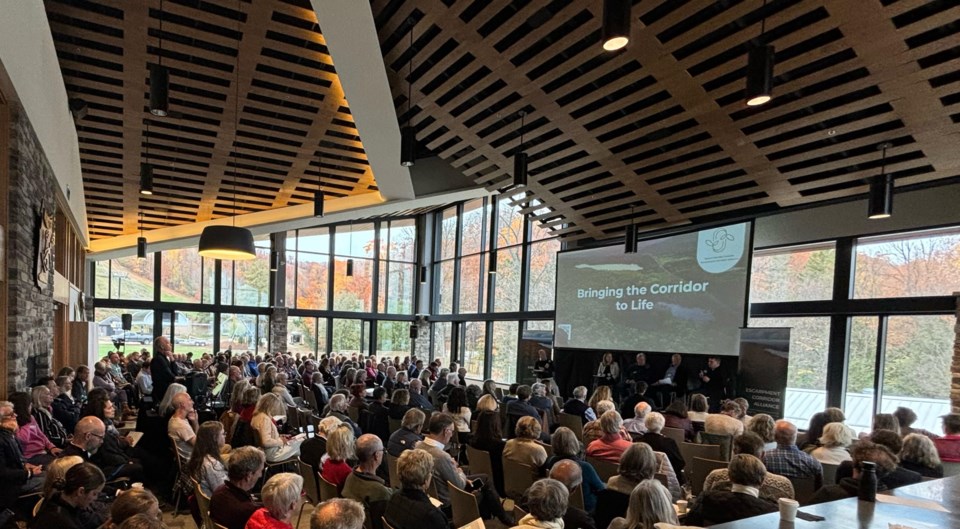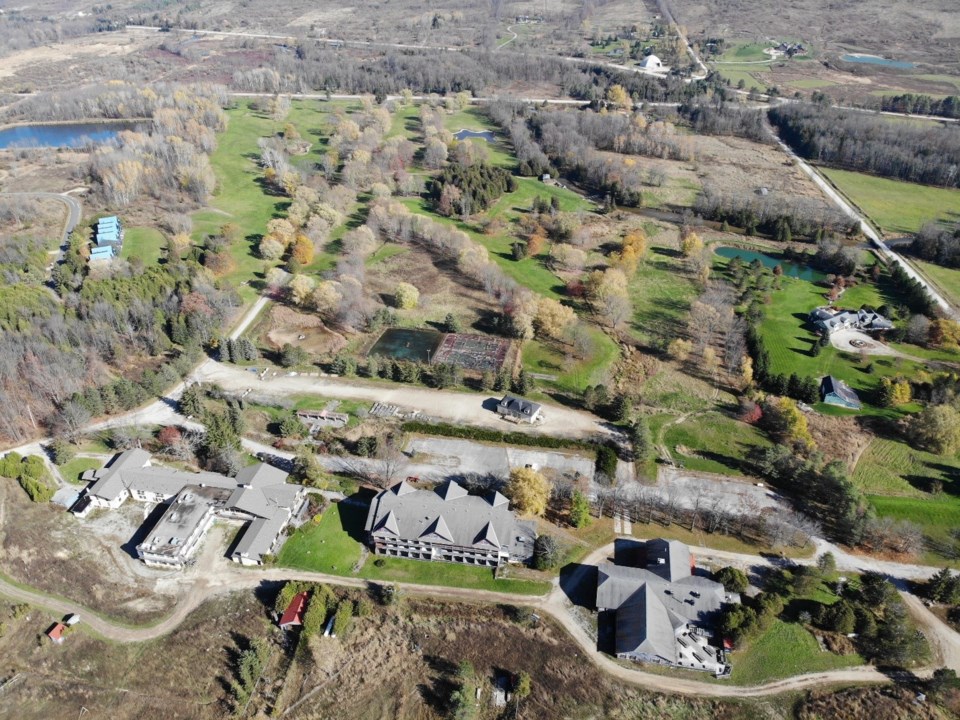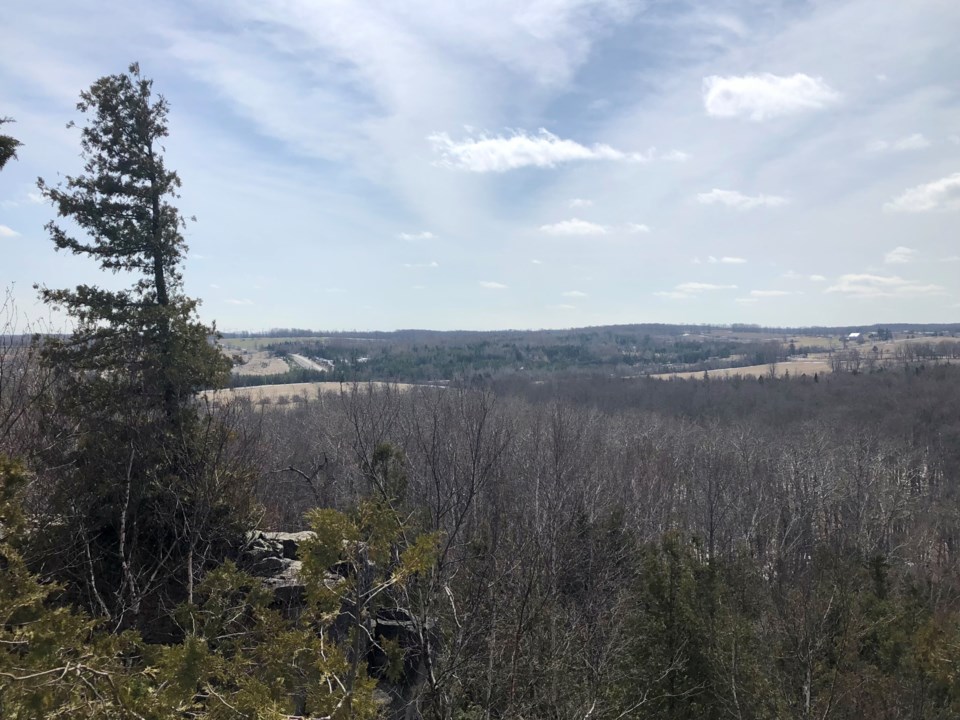Twenty minutes southwest of The Blue Mountains, in the lush Beaver Valley, lies the sleepy village of Kimberley, which boasts two restaurants, a handful of houses and some excellent hiking. If you ask Google Maps for “things to do,” it suggests you drive to Collingwood.
Just outside of Kimberley is the Talisman Mountain Resort. Opened as a ski hill in the 1960s, it’s been abandoned since 2011.
Now, a duo of developers want to turn the former resort into a $400-million wellness retreat — “one of the largest Nordic spas in North America,” complete with a hotel, convention centre, pickleball courts and 900-vehicle parking lot. The project, they say, would become “the premier health and wellness destination for Ontario and beyond.”
Steps will be taken to blend in with the natural environment, they say. The parking lot will be hidden from view with a green roof, and the resort plans to create hiking trails on the property.
“So we're actually enhancing the area with a lot of the things,” said Brian Ellis, one of the developers behind the proposal. “We put a lot of effort into this. My business partner, Phil Calvano, and I, are very, very much in tune with doing a sustainable development.”
Not if Bruce Harbinson gets his way.
“To put that into context, (the project) would be bigger than the (Fairmont) Banff Springs Hotel. The parking lot would be about two–thirds of the Eaton Centre, from what people have told me,” said Harbinson, the president of the Escarpment Corridor Alliance (ECA), which is fighting the Talisman spa and other developments on the escarpment.
Harbinson’s organization recently held a sold-out information session for hundreds of people, at $100 a ticket. He estimates the ECA has reached about 30,000 people over its two-year existence in one form or another.
“We've really caught a nerve up here,” he said.
Harbinson said it’s not just the Talisman lands under threat.


An ‘ecological corridor’ vs. ‘enhancing’ the area
Dotted across the 700-kilometre-long Niagara Escarpment, stretching from Niagara Falls to the Bruce Peninsula, are 34 sites zoned for recreation. In the 1980s, when the Niagara Escarpment Plan was created, the idea was that they could become ski hills — a term referenced liberally in the current plan. Since those resorts would need places for people to stay, the plan allowed for housing to be built nearby.
Today, developers are taking advantage of that old definition to build things, sans ski hill, that are out of step with the area, Harbinson said.
The entire Niagara Escarpment is part of the Greenbelt.
Each of those 34 recreation zones risks fragmenting a natural treasure, Harbinson said. For his group, stopping the spa development is part of a grander dream: an unbroken stretch of green across the top of the escarpment, protected via government fiat and agreements with private landowners.
“What we're effectively trying to do is create a connected and protected ecological corridor that spans the entire escarpment of the southern Georgian Bay,” he said.
“With development pressure being so high in this area, if this doesn't happen soon, we're going to risk permanently fragmented green spaces all up and down this part of the escarpment,” he said.
Ellis said NIMBYism is partly to blame for the resistance to his spa project.
“There's people who don't want to see any development at all on the escarpment, and they'll fight you on everything,” he said.
There’s also sincerity in the opposition, he said, due to a slew of development proposals, especially in nearby Collingwood. But the Beaver Valley is unique, and residents are ready for it to reemerge as a recreational hub, he said.
“They want to see this rejuvenated. They want it back. They want the jobs. They want the amenities. You know, they want the fact that it will bring people to the community to enjoy in a respectful way,” he said.
Ellis contrasted his plans with what could have been.
“I mean, we could have sold this off to — we had a group that wanted to buy it for extreme sports, where they would do, you know, biking and motocross and all kinds of things on the hills, as well as other extreme sports,” he said. “That would have killed — I mean, that would have been recreational, but that wouldn't have been, I think, appropriate for the Beaver Valley.”

Advocates want the province to step in
If Harbinson is to make his vision a reality, it will take some doing.
Right now, the local municipality defines recreation zones as developable land, which doesn’t jive with the Niagara Escarpment Plan, Harbinson said.
It’s these “different interpretations” that Harbinson said worry him.
Grey County, which encompasses the municipality of Grey Highlands, where the Talisman lands lie, said both levels of government allow for "some development" in recreation-zoned areas. Their definitions are modelled after the Niagara Escarpment Plan's, spokesperson Rob Hatten said.
Harbinson said he’s hoping the provincial government will clear it up once and for all through amendments to the Niagara Escarpment Plan to clarify that a recreational facility must be up and running to allow for development nearby — and to add a five-year “use it or lose it” policy for land designated for recreational use, after which it would revert to its natural or protected designation.
There are other ways to deal with the zoning issue, but this one “gets at the heart of the issue” and could be easily done by the province, Harbinson said.
Historically, the allowed “recreational amenities” had to be major in scale and rely on the escarpment itself as part of their function — limiting the approved uses to ski hills and golf courses, he added.
The new spa, while major, wouldn’t rely on the escarpment “and would not be considered an appropriate or acceptable recreational use,” he said.
Those definitions should also be tightened up under the Niagara Escarpment Plan, he said.
The Ford government has not made much progress on more official recommendations to protect the escarpment.
In 2022, the province's auditor general found that the Niagara Escarpment Plan doesn't cover all of the escarpment and that changes made under the previous Liberal government "allow development that harms endangered species' habitats." It made 46 recommendations, only 17 of which have been or are in the process of being implemented.
The Ministry of Natural Resources said it will review the Niagara Escarpment Plan as early as next year. The review may or may not include endangered species, it told the auditor.
In a win for the anti-development crowd, the Niagara Escarpment Commission has weighed in on a different application to build housing near the former Talisman resort. Without an operating ski hill nearby, “additional clarification is needed” from the developers as to how they’ll conform to the Niagara Escarpment Plan, it wrote.
The commission, a provincial agency, manages the escarpment plan and has to approve proposed developments.
“That application is now stalled because the NEC has sided with the comments that we've been making all along in saying that without a recreational amenity, this isn't possible,” Harbinson said.
The commission has yet to comment on the spa application.
“But we don't see how the reaction, particularly from the NEC, will be any different — can't be any different. It's just completely out of scale for the area,” he said.
Ellis said his resort will rely on the natural environment, conforming with the original definition.
The spa pools will be built into the hills, “and that's what makes it such a dynamic area for a Nordic spa like we're building,” he said — not to mention the planned pathways on the hills themselves.
“So it's not skiing, but they can definitely take advantage of the hills for hiking, snowshoeing, tobogganing, whatever,” he said.
In a pre-consultation earlier this year, the Niagara Escarpment Commission said that without the ski hill, “the current development proposal … undermines the original intent” of the recreational zoning.
While he’s still waiting on the commission’s final comments, Ellis said he’s not worried.
“There's always things that you have to work with,” he said. “If we have to make adjustments, or whatever, we’re prepared to do that.”
PCs yet to take a position
Harbinson said he’s had “very positive” meetings with senior staff in Natural Resources Minister Graydon Smith’s office.
“In fact, they were quite grateful that we brought this to their attention,” he said. “I think following what happened with the Greenbelt last year, there was a renewed appreciation for how passionate Ontarians are for their green spaces.”
Staff didn’t know about the zoning issues and were “very appreciative” of being clued in, Harbinson said.
Smith was unwilling to commit to anything in the media.
His office passed a request for comment to the Ministry of Natural Resources, which outlined the responsibilities of the Niagara Escarpment Commission.
Brian Saunderson and Rick Byers, a pair of PC MPPs whose ridings include the upper escarpment, have been “very supportive of our work,” Harbinson said.
Simcoe—Grey's Brian Saunderson said he's had a number of "fruitful" meetings with Harbinson's group, and recently attended an ECA event himself. Though he declined to take a position on whether his government should amend the Niagara Escarpment Plan or whether the spa should go ahead, he said, "we're certainly alert to their concerns."
"They've raised some interesting points, and it's a discussion worth having," he said, regarding NEP amendments.
Byers did not respond to a request for comment by press time.
Ellis said that while he hasn’t spoken to anyone in the provincial government, he’d expect them to support the spa.
“I can't see why they possibly would not,” he said, given the 300 to 400 full-time jobs that would be created, plus the tourism draw.
“Health and wellness communities are the fastest-growing tourism development idea in the world … it’s going to be worth trillions of dollars in the next 10 years. And Ontario doesn't have anything like this,” Ellis said.
“We'll definitely be in touch with our associates at the Ontario legislature and let them know what's going on,” he said.
Ellis said he’s hoping to get approvals from the Niagara Escarpment Commission and the municipality by the summer, which would allow for the spa complex’s construction to start in early 2026.
Harbinson said he hopes his advocacy will pay off soon.
“Right now,” he said, “we have a good shot at doing something that I think would be a remarkable legacy for generations to come.”




